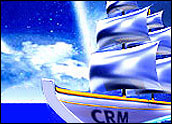
If you came to Boston last week for Siebel’s User Week conference you might have been disappointed. With the impending purchase of the company by Oracle, it would have been easy to regard the event as some kind of “last hurrah” — and what better place than Boston for the atmospherics to pull it off. But instead of a funeral, you were treated to something more akin to the technology industry equivalent of an Irish wake. I can explain.
The mood was upbeat, for a couple of reasons. First, we all know there’s been a bit of a brain drain in San Mateo, something to be expected under the circumstances, but that only sharpened the distinction that most of the Siebel people who attended were there because they wanted to be there. As one veteran told me, some people who will probably be retained by the new regime wanted to go out as an independent company on a high note and others who might not transition simply wanted to go out on a high note for professional reasons. Whatever the motivation, they achieved the goal.
But it wasn’t just Siebel people that made the event. My unscientific survey showed more new customers and more young people in attendance than I had noticed for some time. The importance of new customers is obvious, but the importance of young people may take a little explaining. Early in their careers, people look for a place to settle in and grow, if the sector — or Siebel — was sunsetting as some have suggested, I wouldn’t have seen so many people who cared about “Counting Crows,” Tuesday night’s entertainment.
New Stuff
After many years and many pundits and analysts opining about the importance of accenting the “R” in CRM, Siebel took up the idea and unveiled what it called the next wave of CRM innovation with its Customer Adaptive Solutions. The new direction included analytic enhancements and introductions such as Real-Time Predictive analytics for in-the-moment decisioning, a self assessment tool that supports its six-step customer focused blueprint for success, and perhaps most important, Siebel Component Assembly which is intended to help organizations develop, customize, and deploy service-oriented applications that support these directions.
Siebel has always been known for having a lot of technology, and many competitors have complained or criticized the company for being too technology centric — in some cases a fair point. But the new direction — and the thought leadership that underpins it — cries out for technology that goes beyond the business as usual approach to programming CRM solutions and Component Assembly (though still an unglamorous name) provides a point-and-click environment in which business users can bring together the elements needed to make CRM solutions that fit individual needs.
At the same time, Component Assembly reminds us that with sophisticated enterprise applications, there is a lot that goes on below the waterline. Maybe complex enterprise application development will remain challenging for the foreseeable future, but Component Assembly is a good effort at rationalizing the process and will enable organizations to get application support to users faster and with less agita.
Real-Time Decisions
Speaking of what’s below the waterline, it has been ten years since Peppers and Rogers introduced the concept of the learning relationship and the need for companies to take in customer data, analyze it, and then use it to better service customers and make intelligent offers. Don Peppers was there on Day 2 to talk about return on customer, P&R’s latest thinking on the subject and a perfect lead-in to Siebel’s Real-Time Decisions (RTD) products. Ten years is a long time in this industry, and this introduction especially highlights the great effort it sometimes takes to line up all the technology and influence business culture to implement what seems like a simple idea. Regardless, in an era of relative customer scarcity, RTD, Component Assembly and Customer Adaptive Solutions are exactly the right products and messages to be bringing to market.
Self-Assessment Tool
There were other important introductions, but this isn’t a Siebel ad, so I leave you to peruse the Siebel Web site for other announcements. One last point that is worth talking about though is the Self-Assessment tool. A few years ago I surveyed the Siebel customer base, asking what I thought was a no-brainer question — did the customer perform self-assessment prior to purchase? It seemed like an innocent question, one for which you could almost predict the data, but if you had made any predictions, you might have been disappointed in the answers.
Less than half the customers in the survey said they did the necessary self-exam before plunking down serious money. This single revelation said much about the state of ROI in the market and all of the needless distractions we’ve seen over ROI in the last few years. To be clear, ROI is important, and everyone needs to take responsibility for achieving it, so I was pleased that there is now a self assessment tool to complement the life-cycle blueprint Siebel introduced last year.
Lastly
It seems like Siebel is over any funk that could have been expected after the acquisition announcement. That might be due, at least in part, to good vibes coming from the groups working to merge the two entities. Larry Ellison made a cameo appearance via video in George Shaheen’s key note and made all the right statements about synergy and the additive nature of the merger. At some point you have to take it at face value — at least until someone says or does something to change your mind. The folks at Siebel appear to be holding up their end of the bargain and there is no doubt that the vision and direction outlined last week in Boston will reverberate throughout the industry for some time to come regardless of who owns the Siebel IP.
Denis Pombriant is a well known thought leader in CRM and the founder and managing principal of the Beagle Research Group, a CRM market research firm and consultancy. Pombriant’s latest white paper, Adding Sales to the Call Center Agenda, summarizes his recent research in the call center industry. In 2003, CRM Magazine named Pombriant one of the most influential executives in the CRM industry. Pombriant is currently working on a book to be published next year. He can be reached at [email protected]
























































